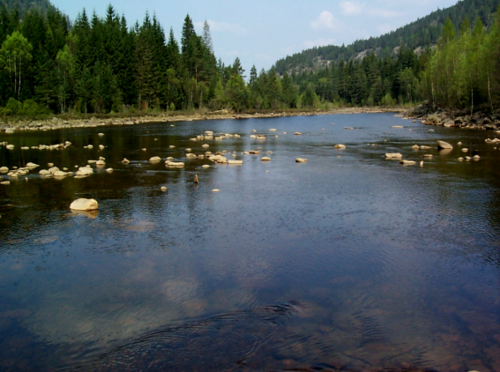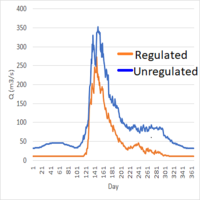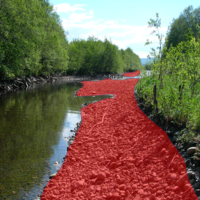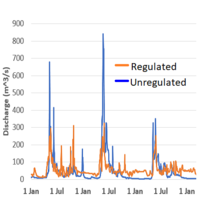Difference between revisions of "Environmental flow"
Bendikhansen (talk | contribs) (Created page with "=Introduction= right|650px|Physical properties of rivers affecting the physical habitat conditions The habitat is the natural home or environment of...") |
|||
| (23 intermediate revisions by 2 users not shown) | |||
| Line 1: | Line 1: | ||
=Introduction= | =Introduction= | ||
| − | [[File: | + | [[File:e-flow.png|thumb|500px|Figure 1: Environmental flow release in Mandal River, Norway]] |
| − | + | Hydropower projects will in most cases change the flow pattern of the affected rivers. The changes in flow are very site-specific and dependent on how the actual project is designed. A hydropower project with a large reservoir for storage of water (‘reservoir-based hydropower’) generally allows much larger changes in flow than a run-of-the river plant. Reservoir-based hydropower can store water from the wet to the dry season and can hence introduce large changes in the periodicity of the flow. Reservoir-based hydropower can also store all or parts of floods, and will typically reduce both the magnitude, peaks and frequency of floods. Run-of-the river plants have limited storage capabilities and will not introduce any changes in the periodicity of the water flow radically, only in hours or a few days’ time horizon. Both storage and run-of-the river plants can, however, short-cut river stretches (‘bypass sections), which will experience dramatically reduced flow in most of the year. | |
| − | + | The habitat conditions are directly affected by the flow and related hydraulic variables such as water depth, water velocity and water-covered areas, and new management practises aim at keeping or restoring natural flow regimes (Poff et al., 2017). Water temperatures are key factors in the development and growth of salmonids (Jonsson and Jonsson, 2011) and are also to a large extent determined by the volumes of water available. The development of the substrate will in longer time horizon be directly affected by the changes in the water flow regime. The functioning of measures presented in this report are also directly dependent on the availability of water and can rarely be implemented without also considering the water flow regime. | |
| − | + | =Environmental flow measures= | |
| − | + | The various measures to mitigate issues concerning environmental flow are listed below. | |
| − | |||
| − | |||
| − | |||
| − | |||
| − | |||
| − | The various measures to mitigate issues concerning | ||
| − | |||
| − | |||
| − | |||
| − | |||
| − | |||
| − | |||
| − | |||
| − | |||
<font size=3 line-height=10><gallery widths=200px heights=200px> | <font size=3 line-height=10><gallery widths=200px heights=200px> | ||
| − | + | GLOMMA_BYPASS_SQUARE.png|[[Mitigating reduced annual flow and low flow measures]] | |
| − | + | stranding_ex_square.png|[[Mitigating rapid, short-term variations in flow (hydro-peaking operations)]] | |
| − | + | bjorset_regulated_square.png|[[Mitigating reduced flood peaks, magnitudes, and frequency]] | |
| − | |||
</gallery></font> | </gallery></font> | ||
| − | == | + | =Relevant literature= |
| − | |||
| − | + | Jonsson, B. and Jonsson, N. 2011. Ecology of Atlantic Salmon and Brown Trout - Habitat as template for life histories. Springer publishing. | |
| − | + | Poff, N.L., Allan, J.D., Bain, M.B., Karr, J.R., Prestegaard, K.L., Richter, B.D., Sparks, R.E. and stromberg, J.C. 1997. The Natural Flow Regime: A paradign fo river conservation and restoration. BioScience 47, 769-784. | |
[[Category: Types of problems]] | [[Category: Types of problems]] | ||
Latest revision as of 20:07, 5 May 2020
Introduction
Hydropower projects will in most cases change the flow pattern of the affected rivers. The changes in flow are very site-specific and dependent on how the actual project is designed. A hydropower project with a large reservoir for storage of water (‘reservoir-based hydropower’) generally allows much larger changes in flow than a run-of-the river plant. Reservoir-based hydropower can store water from the wet to the dry season and can hence introduce large changes in the periodicity of the flow. Reservoir-based hydropower can also store all or parts of floods, and will typically reduce both the magnitude, peaks and frequency of floods. Run-of-the river plants have limited storage capabilities and will not introduce any changes in the periodicity of the water flow radically, only in hours or a few days’ time horizon. Both storage and run-of-the river plants can, however, short-cut river stretches (‘bypass sections), which will experience dramatically reduced flow in most of the year.
The habitat conditions are directly affected by the flow and related hydraulic variables such as water depth, water velocity and water-covered areas, and new management practises aim at keeping or restoring natural flow regimes (Poff et al., 2017). Water temperatures are key factors in the development and growth of salmonids (Jonsson and Jonsson, 2011) and are also to a large extent determined by the volumes of water available. The development of the substrate will in longer time horizon be directly affected by the changes in the water flow regime. The functioning of measures presented in this report are also directly dependent on the availability of water and can rarely be implemented without also considering the water flow regime.
Environmental flow measures
The various measures to mitigate issues concerning environmental flow are listed below.
Relevant literature
Jonsson, B. and Jonsson, N. 2011. Ecology of Atlantic Salmon and Brown Trout - Habitat as template for life histories. Springer publishing.
Poff, N.L., Allan, J.D., Bain, M.B., Karr, J.R., Prestegaard, K.L., Richter, B.D., Sparks, R.E. and stromberg, J.C. 1997. The Natural Flow Regime: A paradign fo river conservation and restoration. BioScience 47, 769-784.



